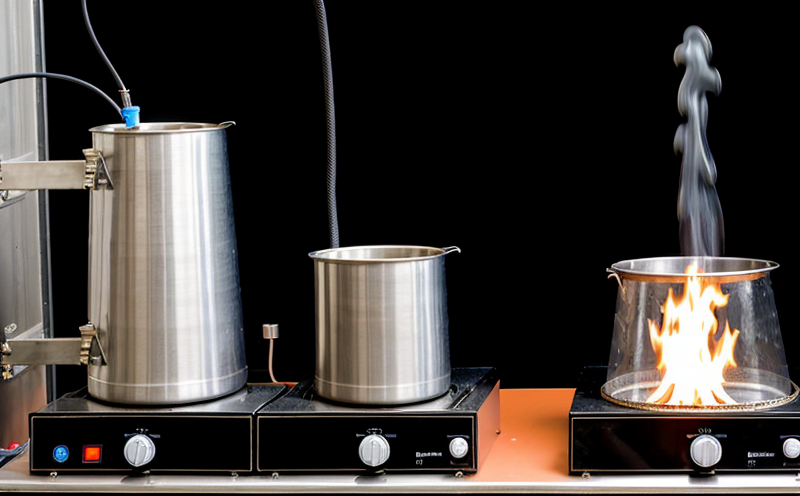Post-Fire Heat Release Analysis
The process of Post-Fire Heat Release Analysis is crucial in understanding the performance and behavior of materials under extreme heat conditions. This analysis helps identify how a material will react when exposed to fire, which is vital for ensuring compliance with international standards such as ISO 5636-1, ASTM E907, EN 45825, and IEC 60695-11-11. Accurate heat release analysis aids in the development of safer materials and products, which is particularly important for sectors like textiles, construction, automotive, and electronics.
When conducting post-fire heat release tests, it's essential to consider several critical factors that can influence results. Specimen preparation involves ensuring the material is representative of the intended application. Factors such as size, shape, and surface finish should be consistent across all specimens being tested. The test environment must also mimic real-world conditions; this includes temperature control, humidity levels, and air flow rates.
The calorimeter used for these tests plays a significant role in obtaining reliable data. Calorimeters measure the total heat evolved during combustion and can provide insights into various aspects of material behavior under fire exposure. By analyzing the calorimetric data, we can determine key parameters like heat release rate (HRR), mass loss, and smoke production index.
Once collected, the calorimetric data undergoes rigorous analysis to interpret its meaning within the context of fire safety. This involves comparing results against established standards and benchmarks to assess performance relative to industry expectations. The insights gained from this analysis help manufacturers improve their products, ensuring they meet regulatory requirements while enhancing overall safety.
Real-world applications of Post-Fire Heat Release Analysis extend beyond mere compliance; it supports continuous improvement initiatives aimed at creating more resilient materials capable of withstanding harsh environments without compromising on performance or environmental impact. For instance, automotive manufacturers use this analysis to ensure that interior textiles and seat covers remain flame retardant even after prolonged exposure to high temperatures.
Additionally, architects incorporate findings from these analyses into building designs to choose appropriate fire-resistant materials for structural components like beams and columns. These decisions contribute significantly towards achieving safer buildings by reducing the risk of fire spread and minimizing damage during emergencies.
In summary, Post-Fire Heat Release Analysis offers valuable information that guides material development efforts across multiple industries. By leveraging this knowledge, organizations can enhance product safety standards while fostering innovation through evidence-based design choices.
Applied Standards
The practice of Post-Fire Heat Release Analysis adheres to several international standards designed to ensure accuracy and consistency in testing protocols. These include ISO 5636-1, ASTM E907, EN 45825, and IEC 60695-11-11. Each standard provides specific guidelines on specimen preparation, calorimeter selection, test procedures, and data interpretation.
For instance, ISO 5636-1 outlines the requirements for testing materials used in protective clothing exposed to flame. It specifies dimensions of specimens, types of calorimeters suitable for the task, and methods for measuring heat release rates (HRR). Similarly, ASTM E907 sets forth procedures for determining the limiting oxygen index (LOI), which helps predict whether a material will ignite or continue burning when supplied with controlled amounts of air.
EN 45825 focuses on fire performance of building products and components, providing detailed instructions on conducting calorimetry tests according to specified conditions. Meanwhile, IEC 60695-11-11 addresses the flammability characteristics of materials intended for use in electrical equipment.
By adhering strictly to these standards during testing processes, laboratories ensure that their findings are comparable and reliable across different regions and industries. This consistency is crucial when sharing results with regulatory bodies or collaborating internationally on research projects involving fire safety.
Quality and Reliability Assurance
Ensuring high-quality outcomes in Post-Fire Heat Release Analysis requires stringent quality control measures throughout the testing process. From specimen preparation to final data interpretation, every step must adhere strictly to established protocols outlined by relevant standards.
One crucial aspect of maintaining reliability is consistent calibration and validation of calorimeters used for testing. Regular checks ensure that instruments operate accurately within specified tolerances defined by respective standards. Additionally, laboratories employ robust quality assurance practices such as internal audits, external reviews, and participation in proficiency testing programs recognized globally.
Moreover, training qualified personnel on best practices contributes significantly towards achieving reliable results. Personnel undergo continuous education to stay updated with advancements in technology and methodologies employed in the field of fire safety research. Such initiatives foster a culture of excellence within laboratories dedicated to providing accurate analyses.
In summary, adherence to quality assurance principles guarantees that Post-Fire Heat Release Analyses conducted by reputable laboratories yield trustworthy data capable of guiding informed decision-making processes in various sectors.
Competitive Advantage and Market Impact
The ability to perform precise and reliable Post-Fire Heat Release Analysis offers significant competitive advantages for companies operating in industries reliant on fire safety. By understanding the exact behavior of materials under extreme heat conditions, organizations can innovate more effective solutions tailored specifically to meet market demands.
For instance, automotive manufacturers leveraging these insights could develop safer interiors with enhanced resistance against ignition risks. Similarly, textile producers might introduce new fabrics boasting superior flame retardancy properties without sacrificing comfort or aesthetics. Such innovations not only enhance product safety but also contribute positively towards societal well-being by reducing fire-related incidents.
In terms of market impact, companies capable of demonstrating robust post-fire performance through rigorous testing protocols enjoy enhanced credibility among consumers and stakeholders alike. This translates into increased trustworthiness and loyalty, ultimately driving sales growth and profitability. Furthermore, compliance with stringent regulatory requirements enhances corporate reputation, making it easier for firms to secure partnerships and expand their footprint globally.
Moreover, participating in collaborative research projects focused on advancing fire safety technologies allows businesses to stay ahead of competitors while contributing positively towards societal well-being. These initiatives foster innovation by encouraging cross-industry collaboration aimed at solving complex challenges related to fire protection.
In conclusion, mastery over Post-Fire Heat Release Analysis equips organizations with the necessary tools to navigate competitive landscapes successfully and make meaningful contributions toward creating safer environments for everyone.





